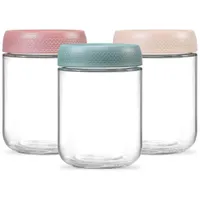How to make homemade dishwasher detergent – this 3-step trick can save both time and money
The simple switch from store-bought to homemade dishwasher detergent can save you money, improve your dishwasher's efficiency, and contribute to a more eco-friendly home


With the benefits of making effective cleaning solutions from household products always on our minds, we've found a cost-effective and eco-friendly alternative to store-bought dishwasher detergent.
Not only does making homemade dishwasher detergent reduce the use of harmful chemicals and plastic packaging but it also means you can create a bulk supply, providing better value for your money compared to commercial alternatives, making it a more environmentally friendly and sustainable choice.
This DIY approach also offers flexibility, allowing you to adjust the mixture according to specific needs, whether combating hard water issues or residue build-up.
Our experts have explained how to create homemade dishwasher detergent in three simple steps and some additional cleaning tips.
How to make homemade dishwasher detergent
Even with the best dishwasher, you can still improve the efficiency of your dishwasher's cleaning abilities with this great addition to your cleaning supplies list.
The key to creating an effective homemade dishwasher detergent is using the right combination of items you can substitute for dishwasher tablets that are not only environmentally friendly but also powerful enough to clean dishes thoroughly.
DIY Dishwasher Detergent Ingredients

- 1 cup of borax
- 1 cup of washing soda
- 1/2 cup citric acid (you can find this Viva Doria citric acid at Amazon)
- 1/2 cup kosher salt
- Essential oils (optional)
These ingredients help to break down food particles and grease while preventing water spots and residue on dishes. Baking soda removes odors and stains, washing soda cuts through grease, citric acid targets tough food residues, and kosher salt acts as a natural water softener.
Design expertise in your inbox – from inspiring decorating ideas and beautiful celebrity homes to practical gardening advice and shopping round-ups.
Borax 20 Mule Team Laundry Booster | Was $16.00, now $8.77 at Amazon
Making your own dishwasher detergent is often more cost-effective than buying commercial products, especially if you buy the ingredients in bulk.
How to make your own DIY dishwasher detergent

Begin by carefully measuring out all the ingredients. 'Accuracy is essential to ensure the effectiveness of the detergent and prevent any unwanted reactions,' says Karina Toner, operations manager at Spekless Cleaning.
1. Mix the ingredients
'In a container, combine the washing soda, borax, citric acid, and kosher salt. Make sure all ingredients are mixed well by stirring it thoroughly,' advises Daniel Brown, professional cleaner at Handy Cleaners.
Consider adding a few drops of essential oils such as lemon, tea tree, or peppermint to the mixture. Not only do these essential oils add a fresh scent, but they also possess antibacterial properties that can help sanitize dishes.
2. Store the detergent
Transfer the mixture to a container with an airtight seal, such as a leftover jam or mason jar.
'Store the homemade detergent in a cool, dry place away from moisture to prevent clumping,' advises Karina Toner.
Consider labeling the container with the contents and usage instructions for future reference.
NETANY Glass Jars | Was $12.99, now $11.99 from Amazon
These 3 glass jars with airtight lids are 16oz each, making them perfect for storing your homemade laundry detergent in bulk.
3. Add it to your dishwasher
Yes, it's really that simple, now you can add the detergent to your dishwasher to see the results of your efforts.
Add 1-2 tablespoons of the mixture to your dishwasher's detergent compartment before starting the wash cycle.
Karina Toner recommends: 'Adjust the amount based on the fullness of your dishwasher and the residue on your dishes.'
Additional tips

Avoid clumps: 'If you find that the detergent is clumping when storing, add a few rice grains to the container,' advises Daniel Brown. 'The rice performs as a desiccant by absorbing all the extra moisture, ensuring your detergent remains efficient.
Make adjustments for hard water: 'If you live in an area with hard water, you may need to increase the amount of citric acid. This will help you avoid hard water stains leaving residue on your dishes.
Use rinse aid: 'Vinegar can work well as your natural rinse aid. To clean a dishwasher with vinegar, add a cup of white vinegar to the rinse-aid compartment to reduce the chance of spots on your clean dishes.'
Fix cloudy glassware: If you are wondering why your glasses are going cloudy in the dishwasher, we might have just the solution for you. Using less detergent will reduce the chance of residue build-up which can contribute to cloudiness. You can also add more citric acid to the mixture since this effectively breaks down mineral deposits and hard water stains.
While homemade dishwasher detergents are generally safe, handle ingredients such as borax and citric acid with care. Avoid direct contact with skin or eyes and keep the detergent out of reach of children and pets.
We recommend using safety gloves while mixing the ingredients.

Lola Houlton is a news writer for Homes & Gardens. She has been writing content for Future PLC for the past six years, in particular Homes & Gardens, Real Homes and GardeningEtc. She writes on a broad range of subjects, including practical household advice, recipe articles, and product reviews, working closely with experts in their fields to cover everything from heating to home organization through to house plants. Lola is a graduate, who completed her degree in Psychology at the University of Sussex. She has also spent some time working at the BBC.

